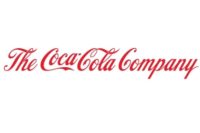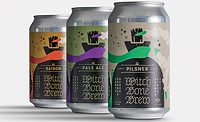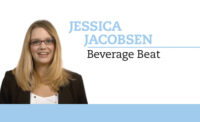Real Change for America’s Health
By Elizabeth Fuhrman
Health and wellness politics show consumers voting for functional, superfruit and organic beverages
The presidential
candidates would have you believe that Americans want nothing as much as
change this year. Beverage trends are showing a similar request for change.
Consumers are voting with their wallets for new products they can feel good
about.
Functional drink sales reached $19.2 billion and
better-for-you beverages grew to nearly $14.9 billion in the United States
in 2006, according to Euromonitor International, Chicago.
The gains are expected to continue. By 2011, the
functional beverage category is projected to surge to $29.1 billion and
better-for-you beverages to $18 billion.
“Beverages in general are the growth darlings,
if you will, of the industry right now,” says Sheila McCusker, editor
of Chicago-based Information Resources Inc.’s (IRI) Times &
Trends. “In consumer packaged goods, beverages grew over 5 percent
last year, which is exceptionally high in an industry that’s growing
at about 3 percent a year as a whole. So beverages continue to bring
tremendous growth to retailers, and what’s really driving that is
health and wellness beverages.”
New healthier beverage innovation is helping spur
category growth. Nearly 380 new vitamin- and mineral-fortified beverages
were launched last year, according to Mintel Global New Products Database
(GNPD). Add to that more than 200 new low-, no- or reduced-sugar beverages
and more than 150 new low-, no- or reduced-calorie drinks. Mintel also
reported more new functional; added calcium; weight control; low-, no- or
reduced sodium and low-, no- or reduced fat beverages were added.
“This space right now is all about
innovation,” McCusker says. “There is a ready and waiting
market for healthier beverages, especially offering ingredients that carry
specific health benefits. Consumers are much more tuned into specific
ingredients than they used to be. They are looking for them.”
Functional: ‘Yes we can’
Showing the proactive nature of the country, the
majority of consumers believe they have control over their health.
“Consumer awareness of diet and health
relationships is at an all-time high,” said Richard Elder, director
of the International Food Information Council (IFIC) and the IFIC
Foundation at the 2007 World Wide Food Expo in October. IFIC released
statistics on consumers’ general attitudes toward health from two
studies, “2007 Consumer Attitudes Toward Functional Foods/Foods for
Health” and the “2007 Food & Health Survey.”
The surveys showed that the majority of consumers rate
their health status as good, very good or excellent, which is a significant
increase from consumers’ feelings in 2006. However, not all consumers
are satisfied with their health status. Heart issues, including heart
disease, blood pressure, cholesterol and stroke, are the leading health
concerns for American consumers. Weight, cancer, diabetes, nutrition/diet and exercise follow.
The good news for beverages and foods is that 75
percent of consumers surveyed in the reports feel that nutrition plays the
greatest role in health. Additionally, 66 percent of consumers report
making changes to improve the healthfulness of their diets in 2007, which
is a significant increase over the year before.
While the majority of consumers are consuming less of
a specific type of beverage or food to improve the healthfulness of their
diet, Elder added, “40 percent of those surveyed said they are
consuming more of a specific type of food or beverage” and “36
percent are eating more of a certain food component.”
This finding correlates with the fact that the
majority of consumers agree that certain foods have health benefits beyond
basic nutrition, Elder said. “Ninety-two percent of consumers can
name a food and its associated benefit,” he said.
This bodes well for functional beverages. Beverages
that provide one or more of the following functions are leading the market:
energy (green tea, caffeine and ginseng), vitamins and minerals (including
calcium and vitamin D), nutrients (such as fiber, omega-3 and sterols),
satiety (fiber, fatty acids and amino acids), superfruits and probiotics.
Energy drinks continue to grow exceptionally well,
increasing 30 percent in 2007, according to IRI’s McCusker.
“That is tapping into the whole functional market where consumers are
looking for foods and beverages to do more than
just provide satisfaction; they are looking for actual health and wellness
benefits,” she says. “Energy is a huge, huge, hugely sought
after attribute right now.”
Antioxidants also are displaying massive popularity.
“Consumers are looking for beverages that are going to help with
disease prevention,” McCusker says. “That is really fueling the
growth of refrigerated teas and coffee.” The RTD tea and coffee
category grew 28 percent last year.
Another flourishing market in the better-for-you
beverage category is bottled water. Bottled water sales have seen growth
for a decade and still earned double-digit growth last year, McCusker says.
To top that, enhanced bottled waters boasted 42 percent gains in 2007.
“Regular bottled water is growing exceptionally
well, but what is also fueling that growth is enhanced waters, whether
it’s vitamin enhanced, or enhanced with specific superfruits that
offer antioxidants, or it’s enhanced with energy or protein”
she says.
The dairy case also has been the starting ground for
functional benefits such as probiotics and omega-3 fatty acids, which are
beginning to move into other beverage categories. Probiotics, which aid in
digestive health and support the immune system, have been popularized by
Dannon Activia yogurt, and its dairy-based, probiotic beverage offspring
DanActive, and now appears in Naked Juice Probiotics.
“Dannon Activia yogurt burst open the door last
year,” McCusker says. “I think it surprised a lot of people
that consumers will buy this. They do understand it. I know Dannon put a
lot of money into educating consumers, and I think that really helped to
open the door to the market. We’re now seeing probiotics in
beverages. That’s going to be a very hot area to watch.”
Omega-3 fatty acids, esteemed for their heart health
advantages, are another complex ingredient that consumers appear to
understand better these days. With heart disease as the leading disease in
America, omega-3’s presence is increasing in the dairy case and in
refrigerated juices. “I would expect omega-3 to start appearing in
other areas of the beverage industry as well,” McCusker says.
The next generation of functional beverages will
target specific consumer concerns like joint health, high cholesterol, high
blood pressure and diabetes. “To a large extent, when you’re
looking at the energy side of the fence or even the antioxidants, a lot of
them are in beverages that have strong appeal among younger
consumers,” McCusker says. “But increasingly, I think
we’ll see them targeting the aging boomer segment with very specific
disease management.”
Additionally, McCusker is surprised that more
functional beverages aren’t available for children. Only a few
products on the market promote any functional benefits, such as
antioxidants. “That’s kind of a wide open area as consumers are
looking for ways to enhance their children’s future health,”
she says.
Weight: ‘Solutions for America’
Diets are a girl’s — and now even a
guy’s — best friend. More than 72 million Americans are on a
diet, which is less than voted in the last presidential election, but more
than the 55 million a decade ago, says John LaRosa, research director of
Marketdata Enterprises, Tampa, Fla.
The Centers for Disease Control and Prevention’s
(CDC) latest data (from November 2007) reports that more than one-third of
U.S. adults — more than 72 million people — were obese in
2005-2006. This includes 33.3 percent of men and 35.3 percent of women. The
figures, though, show no statistically significant change from 2003-2004,
when 31.1 percent of men were obese and 33.2 percent of women were obese,
the CDC says.
With “The Biggest Loser” television show
hitting top rankings in the number of viewers watching, it is no surprise
that Americans’ minds are on losing weight. Programs such as Weight
Watchers, NutriSystem and Jenny Craig lead the way in diet plans, but
choices like The Sonoma Diet, which follows a Mediterranean inspired
lifestyle, including drinking wine, are making gains.
Other diets though, such as Atkins and South Beach,
have seen interest wane. Five years after “The South Beach
Diet” book published, sales of Kraft Foods Inc.’s South Beach
Diet foods have slowed dramatically from the $250 million spike it reached
in 2006. Aiming to turn those numbers around, Kraft changed its
line’s name from “South Beach Diet” to “South Beach Living,” and reframed its philosophy. South
Beach Living foods are for people who want to eat healthier and manage
their weight as part of their ongoing lifestyle, the company says. The
products still offer the same foods based on the principles of The South
Beach Diet, such as lean protein, fiber, whole grains, vegetables and
unsaturated fats.
“The new name reflects a long-term approach to
healthy eating vs. the short-term view people often take on dieting,”
said Ryan Clark, director of marketing for South Beach Living Foods, in a
statement.
The brand also added more new products to the line,
including two drink mixes. South Beach Living Tide Me Over Drink Mixes, in
Natural Strawberry Banana and Natural Tropical Breeze varieties, offer a
low-calorie fruit flavor to bottled water, and provide 3 grams of protein
and 5 grams of fiber.
IRI reports that beverage and food products with
weight management benefits, including portion control, reduced fat and
calories, are outpacing total consumer packaged goods sales by a
significant margin.
Additionally, light alternatives are well-established
among several major beverage categories, including milk, beer and
carbonated beverages. Given the availability of light options across the
beverage categories, IRI says it appears that consumers may be more likely
to target beverages than foods for calorie reduction. Across beverages,
growth trends among light options are slightly more favorable than total
category growth trends. Bottled juices are an exception, with light
products trailing total category growth, which could possibly be attributed
to a flavor factor.
“I’m not sure all the brands have tapped
that taste barrier, but there are some highly successful juice products in
the light segment that will spur growth within that light segment,”
McCusker says.
Miller Brewing Co. is hoping its new lighter option
will spark beer sales for its Miller Genuine Draft brand. Set to be
available in March in the Midwest with a national rollout likely, MGD 64
has a little more than half the calories of MGD Light’s 110 calories.
Targeted toward females, MGD 64 would replace MGD Light in the marketplace.
The beer is the lowest-calorie mass-market domestic beer, although
Beck’s Premier Light from Belgium’s InBev also boasts
64-calories.
In addition to more light beverage options, portion
control is starting to play a roll in beverages, particularly in school
systems. (See sidebar). “We are starting to see smaller portions on
beverages and calling out, especially on low-calorie [products], the exact
number of calories, particularly a 100 calories or under,” McCusker
says. “I think a big market that’s untapped is
portion-controlled healthy beverages targeting kids.”
Super superfruits
With many more superfruits entering the beverage
market than the 24 states that held primaries and caucuses on Super
Tuesday, beverage companies are the key industry for including superfruits
in their products, with around 35 percent of new beverages featuring the
antioxidant-laden giants, according to Mintel’s GNPD.
Superfruits are becoming increasingly mainstream.
Longer-established varieties, such as blueberry and cranberry, continue to
increase in usage as pomegranate maintains its growth and acai, noni,
mangosteen and goji emerge. Even newer varieties such as acerola,
dragonfruit and camu camu are appearing, and superfruit blends are
countless.
Superfruits also contributed to functional beverage
sales increases and RTD tea growth. “That area just continues to
expand as more fruits are discovered and made more aware of their
benefits,” McCusker says.
While the potential benefits of antioxidants and
nutrients such as vitamin C are widely accepted, manufacturers still have
to accurately report the claims they make for various superfruits. For
example, the Food and Drug Administration has issued warnings to some
companies over claims made for goji. Negative coverage may undermine
consumer confidence in superfruits’ potential health benefits, Mintel
says.
But beverages delivering any type of fruit or
vegetable servings are a hot ticket item for consumers right now, McCusker
says. Only approximately a quarter of the population is consuming five or
more servings of fruits or vegetables a day. “We’ve had some
successful products in that space, but I think we’ll see a lot
more,” she says.
Organics: ‘True strength’
In addition to reaching for products with healthier
ingredients, consumers also are avoiding products that may contain harmful ingredients, which is proved by the solid
growth in organic and natural products. According to a 2007 Nielsen global
study, 57 percent of North Americans say the main reason they choose
organic products is because “it’s healthier for me.”
While organic products and functional foods are
popular with consumers, many consider them to be too pricey, with half of
North Americans saying cost is the main reason for not buying organics,
Nielsen reports. The U.S. organics shopper, who tends to be younger and
have a family, spends as average of $127 on their weekly grocery bill,
according to Scarborough Research. This is 10 percent higher than the
national norm of $115.
Consumers many not be convinced of the necessity of
organics regarding health, especially in some processed food categories,
Mintel says. Shoppers may opt for natural or mainstream products, and save
their “organic dollars” for segments such as dairy, produce and
meat, where they feel organics are safer and more beneficial.
Changes for children too
Calories from beverages
shipped to schools nationwide have dropped 41 percent after the beverage
industry’s first year of implementing the National School Beverage
Guidelines, according to the American Beverage Association (ABA), which
created the guidelines. The three-year initiative calls for the reduction
of beverage calories in schools by providing a range of lower-calorie,
nutritious, small-portion beverages and the removal of full-calorie soft
drinks by the 2009-2010 school year.
“I am thrilled with the first-year
results,” says Susan Neely, president and chief executive officer of
the ABA. “No other sector of the food industry has stepped up to the
plate the way the beverage industry has and done something meaningful to
support the effort for food nutrition and education in schools.”
The School Beverage Guidelines are embodied in a
memorandum of understanding between the Alliance for a Healthier Generation
(a joint initiative of the American Heart Association and the William J.
Clinton Foundation), the ABA, Cadbury Schweppes Americas Beverages, The
Coca-Cola Co. and PepsiCo Inc. Each year, the industry has to meet markers
in terms of implementation, and it has met every first year marker, Neely
says.
Shipments of full-calorie soft drinks have decreased
45 percent between the 2004 and 2006-2007 school year, according to the
“School Beverage Guidelines Progress Report 2006-2007.” The
report shows that the average high school student consumes less than half a
can of full-calorie soft drink a week in school, compared with a little
more than a full can a week in 2004. In contrast, shipments of bottled
waters to schools are up by 23 percent from 2004.
School contracts also are on track for the three-year
plan. For the first year, 35 percent of all contracts between bottlers and
school districts have achieved compliance with the guidelines.
Changing the school beverage landscape hasn’t
been an easy task though. With approximately 125,000 school districts in
the country, the gains made during the first year are noteworthy given the
challenges associated with educating and training bottlers and schools,
revising financial arrangements, and, not to be stated lightly,
reformulating and repackaging product lines and reconfiguring vending
equipment, Neely says.
“Some of the products have to be in smaller
portion sizes as part of the new beverage policy, like 100 percent
juices,” she explain. “The large concentrate companies had to
commit to reformulating those products so they would meet the new portion
sizes, and in some cases a new container had to be created, so a 100
percent juice could go into schools and actually be vended.”
With many bottlers’ sales forces trained on the
guidelines, data reporting methods for the system set and the substantial
marketing undertaken last year, the second year should prove a little
easier, but the hard work of continuing to change the beverage selections
in schools still remains. The key marker for year two: 75 percent of
schools under contract need to be in compliance.




